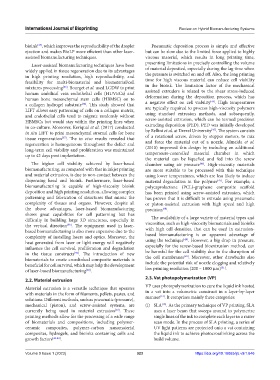Page 331 - IJB-9-1
P. 331
International Journal of Bioprinting Review on Hybrid Biomanufacturing Systems
bioink , which improves the reproducibility of the droplet Pneumatic deposition process is simple and effective
[34]
ejection and makes BioLP more efficient than other laser‑ but can be slow due to the limited force applied to highly
assisted biomanufacturing techniques. viscous material, which results in long printing time,
Laser-assisted biomanufacturing techniques have been presenting limitations in precisely controlling the volume
widely applied in tissue regeneration due to its advantages of material deposited, especially during the lag time when
in high printing resolution, high reproducibility, and the pressure is switched on and off. Also, the long printing
feasibility for multi-biomaterial and biomaterial/cell time for high viscous material can reduce cell viability
mixtures processing . Bourget et al. used LGDW to print in the bioink. The limitation factor of the mechanical
[35]
human umbilical vein endothelial cells (HUVECs) and assisted extruders is related to the shear stress-induced
human bone mesenchymal stem cells (HBMSC) on to deformation during the deposition process, which has
[44]
a collagen hydrogel substrate . This study showed that a negative effect on cell viability . High temperatures
[36]
LIFT allows easy patterning of cells on a collagen matrix, are typically required to process high-viscosity polymers
and endothelial cells tend to migrate randomly without using standard extrusion methods, and subsequently,
HBMSCs but would stay within the printing lines when screw-assisted extrusion, which can be termed precision
in co-culture. Moreover, Keriqual et al. (2017) conducted extruding deposition (PED). PED was initially developed
[45]
in situ LIFT to print mesenchymal stromal cells for bone by Bellini et al. at Drexel University . The system consists
tissue regeneration . The in vivo results revealed that of a rotational screw, driven by stepper motors, to mix
[37]
regeneration is homogeneous throughout the defect and and force the material out of a nozzle. Almeida et al.
long-term cell viability and proliferation was maintained (2010) improved this design by including an additional
up to 42 days post implantation. temperature-controlled material chamber in which
the material can be liquefied and fed into the screw
The higher cell viability achieved by laser-based chamber using air pressure . High-viscosity materials
[46]
biomanufacturing, as compared with that in inkjet printing are more suitable to be processed with this technique
and material extrusion, is due to non-contact between the using lower temperatures, which are less likely to induce
dispensing head and bioink. Furthermore, laser-based material degradation in the polymer . For example, a
[47]
biomanufacturing is capable of high-viscosity bioink polycaprolactone (PCL)-graphene composite scaffold
deposition and high printing resolution, allowing complex has been printed using screw-assisted extrusion, which
patterning and fabrication of structures that mimic the has proven that it is difficult to extrude using pneumatic
complexity of tissues and organs. However, despite all or piston-assisted extrusion with high speed and high
the above advantages, laser-based biomanufacturing precision .
[48]
shows great capabilities for cell patterning but has
difficulty in building large 3D structures, especially in The availability of a large variety of material types and
the vertical direction . The equipment used in laser- viscosities, such as high-viscosity biomaterials and bioinks
[38]
based biomanufacturing is also more expensive due to the with high cell densities, that can be used in extrusion-
complexity of installing lasers and optics. Moreover, the based biomanufacturing is an apparent advantage of
[49]
heat generated from laser or light energy will negatively using the technique . However, a big drop in pressure,
influence the cell survival, proliferation and degradation especially for the screw-based bioextrusion method, can
in the tissue constructs . The introduction of new be harmful for the cell viability due to the disruption of
[39]
[50]
biomaterials to create crosslinked composite materials is the cell membranes . Moreover, other drawbacks also
beneficial for cell survival, which may help the development include the potential risk of nozzle clogging and relatively
[51]
of laser-based biomanufacturing . low printing resolution (200 – 1000 µm) .
[40]
2.2. Material extrusion 2.3. Vat photopolymerization (VP)
Material extrusion is a versatile technique that operates VP uses photopolymerization to cure the liquid ink hosted
with materials in the form of filaments, pellets, pastes, and in a vat into a volumetric construct in a layer-by-layer
[14]
solutions. Different methods, such as pneumatic (pressure), manner . It comprises mainly three categories:
mechanical (piston), and screw-assisted systems, are (i) SLA . As the primary technique of VP printing, SLA
[15]
currently being used in material extrusion . These uses a laser beam that sweeps around to polymerize
[13]
printing methods allow for the processing of a wide range single lines of the ink to complete each layer in a raster
of biomaterials and compositions, including polymer- scan mode. In the process of SLA printing, a series of
ceramic composites, polymer-carbon nanomaterial UV light patterns are projected onto a vat containing
composites, hydrogels, and bioinks containing cells and the liquid ink to achieve photocrosslinking across the
growth factors [41-43] . build volume.
Volume 9 Issue 1 (2023) 323 https://doi.org/10.18063/ijb.v9i1.646

